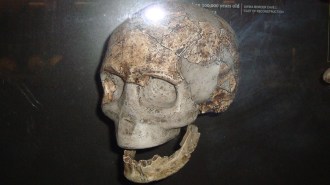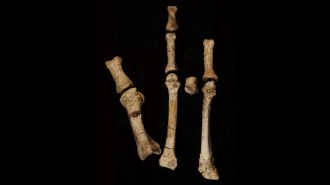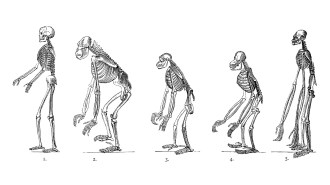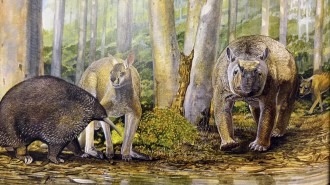Hybrid-Driven Evolution: Genomes show complexity of human-chimp split
Not only did the evolutionary parting of human from chimpanzee ancestors occur more recently than had been indicated by previous data, but it also played out over an extended period during which forerunners of people and chimps interbred.
That controversial possibility arises from a new genetic comparison of people, chimps, gorillas, orangutans, and macaque monkeys.
Various parts of the human genome diverged from those of chimps at times that span at least 4 million years, concludes a team led by geneticist David Reich of Harvard Medical School in Boston. A final genetic split, yielding reproductively separate ancestral species of humans and chimps, transpired between 6.3 million and 5.4 million years ago, the scientists report in the June 29 Nature.
Most scientists had held that hominids and ancient chimps branched off from a common ancestor roughly 7 million years ago, with no interbreeding.
Clues to ancient interbreeding lie on the X chromosome, Reich and his coworkers say. People and chimps exhibit far more similarity on that sex-linked DNA strand than on any of the other 22 chromosomes. Genetic detachment of human ancestors, or hominids, from chimps seems to have occurred on the X chromosome about 1.2 million years later than it did on other chromosomes, the scientists report.
A partial genetic cleavage of hominids and chimp ancestors, followed by interbreeding that reshaped the sex chromosomes, then a conclusive split, best explains these findings, in the researchers’ view. If they’re right, then presumed hominid fossils from more than 6 million years ago (SN: 7/13/02, p. 19: Evolution’s Surprise: Fossil find uproots our early ancestors) would have preceded the final split and actually come from hybrid creatures.
“Something very unusual happened at the time of [human-chimpanzee] speciation,” Reich says.
His team aligned 20 million base pairs from the genomes of five modern primates. The researchers then identified sites containing two alternative versions of the same gene across the species. In this way, they assessed the extent to which humans and chimps, as well as other species combinations, shared gene variants.
Previous work underestimated genetic similarities in people and chimps, the investigators say, and placed the evolutionary parting of these species about 1 million years too early.
Although hybridization influences species evolution in plants and in some animals, scientists hadn’t looked for it in primates.
Given the new genetic findings, though, it’s plausible that after a partial split, hominid interbreeding with chimps yielded fertile females and infertile males, Reich and his colleagues propose. Hybrid females would then have resorted to mating with fertile chimp or hominid males. Because they would have produced fertile sons only when the mothers passed on X chromosomes mostly from one of the original species, this process eventually would have led to a final split.
Harvard anthropologist David Pilbeam calls the new study “terrifically exciting and important work.” He lauds Reich’s method for estimating the human-chimp genetic divergence.
Still, as extensive genetic sequences of the many other primates become available, Pilbeam suspects that the timing of the final hominid-chimp split will be moved back far enough to disprove the hybridization hypothesis. He doubts that ancient interbreeding would have generated any fertile offspring.
Anthropologist Jeffrey H. Schwartz of the University of Pittsburgh sees no merit in the new findings. Reich’s team looked for data to support an assumption of close genetic ties between humans and chimps but skimmed over evidence of human similarities to other primates, Schwartz asserts.
The hybridization hypothesis “pushes the limits of credulity,” Schwartz says.







